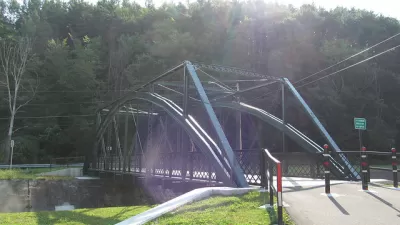In California, a billion gallons of water ends up in the ocean every day. A new bill seeks to curb this practice by requiring treatment facilities to increase recycling and reuse efforts.

California legislators want to see less rainwater discharged into the Pacific Ocean and state estuaries. "SB 332, the Local Water Reliability Act, calls on wastewater treatment facilities to step up recycling, conservation and efficiency to meet reduction targets of 50 percent by 2030 and 95 percent by 2040 for the amount of water dumped into the ocean," reports Kevin Modesti.
State Senators Bob Hertzberg and Scott Wiener, the bill’s backers, say that California communities often use water once and then dispose of it, up to 1.1 billion gallons a day. "Hertzberg cited a climatologist’s estimate, reported in the Los Angeles Times, that more than 80 percent of the region’s rainfall ends up diverted from urban areas in Southern California into the Pacific Ocean," notes Modesti.
They argue that the water should be recycled and used for landscape and agricultural irrigation to reduce the practice of diverting water to Southern California from the Colorado River and the Bay-Delta watershed in the northern part of the state.
Hertzberg backed a similar bill in 2015 that faced opposition from water agencies citing the immense costs that would come along with reuse mandates. The earlier bill did not get past the committee level, but the Association of California Water Agencies has not yet taken an official stance on the latest bill.
FULL STORY: See all that water flowing into the ocean? Bill by Sen. Hertzberg aims to save it

Alabama: Trump Terminates Settlements for Black Communities Harmed By Raw Sewage
Trump deemed the landmark civil rights agreement “illegal DEI and environmental justice policy.”

Planetizen Federal Action Tracker
A weekly monitor of how Trump’s orders and actions are impacting planners and planning in America.

The 120 Year Old Tiny Home Villages That Sheltered San Francisco’s Earthquake Refugees
More than a century ago, San Francisco mobilized to house thousands of residents displaced by the 1906 earthquake. Could their strategy offer a model for the present?

In Both Crashes and Crime, Public Transportation is Far Safer than Driving
Contrary to popular assumptions, public transportation has far lower crash and crime rates than automobile travel. For safer communities, improve and encourage transit travel.

Report: Zoning Reforms Should Complement Nashville’s Ambitious Transit Plan
Without reform, restrictive zoning codes will limit the impact of the city’s planned transit expansion and could exclude some of the residents who depend on transit the most.

Judge Orders Release of Frozen IRA, IIJA Funding
The decision is a victory for environmental groups who charged that freezing funds for critical infrastructure and disaster response programs caused “real and irreparable harm” to communities.
Urban Design for Planners 1: Software Tools
This six-course series explores essential urban design concepts using open source software and equips planners with the tools they need to participate fully in the urban design process.
Planning for Universal Design
Learn the tools for implementing Universal Design in planning regulations.
Clanton & Associates, Inc.
Jessamine County Fiscal Court
Institute for Housing and Urban Development Studies (IHS)
City of Grandview
Harvard GSD Executive Education
Toledo-Lucas County Plan Commissions
Salt Lake City
NYU Wagner Graduate School of Public Service




























